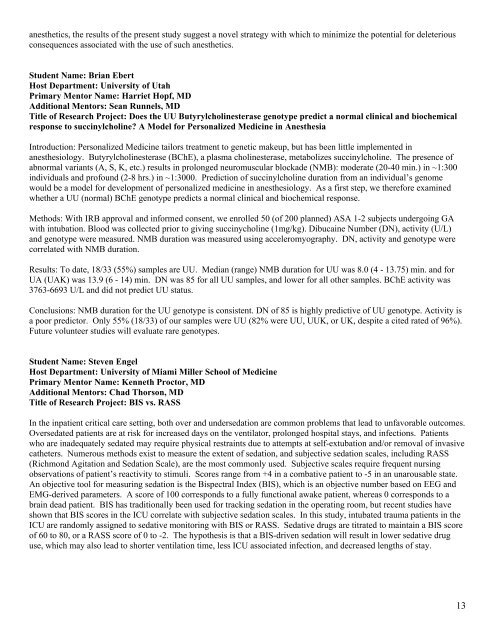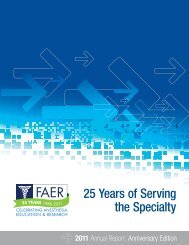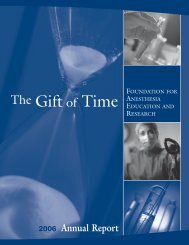2010 MSARF Symposium Participants - Foundation for Anesthesia ...
2010 MSARF Symposium Participants - Foundation for Anesthesia ...
2010 MSARF Symposium Participants - Foundation for Anesthesia ...
Create successful ePaper yourself
Turn your PDF publications into a flip-book with our unique Google optimized e-Paper software.
anesthetics, the results of the present study suggest a novel strategy with which to minimize the potential <strong>for</strong> deleterious<br />
consequences associated with the use of such anesthetics.<br />
Student Name: Brian Ebert<br />
Host Department: University of Utah<br />
Primary Mentor Name: Harriet Hopf, MD<br />
Additional Mentors: Sean Runnels, MD<br />
Title of Research Project: Does the UU Butyrylcholinesterase genotype predict a normal clinical and biochemical<br />
response to succinylcholine? A Model <strong>for</strong> Personalized Medicine in <strong>Anesthesia</strong><br />
Introduction: Personalized Medicine tailors treatment to genetic makeup, but has been little implemented in<br />
anesthesiology. Butyrylcholinesterase (BChE), a plasma cholinesterase, metabolizes succinylcholine. The presence of<br />
abnormal variants (A, S, K, etc.) results in prolonged neuromuscular blockade (NMB): moderate (20-40 min.) in ~1:300<br />
individuals and profound (2-8 hrs.) in ~1:3000. Prediction of succinylcholine duration from an individual’s genome<br />
would be a model <strong>for</strong> development of personalized medicine in anesthesiology. As a first step, we there<strong>for</strong>e examined<br />
whether a UU (normal) BChE genotype predicts a normal clinical and biochemical response.<br />
Methods: With IRB approval and in<strong>for</strong>med consent, we enrolled 50 (of 200 planned) ASA 1-2 subjects undergoing GA<br />
with intubation. Blood was collected prior to giving succinycholine (1mg/kg). Dibucaine Number (DN), activity (U/L)<br />
and genotype were measured. NMB duration was measured using acceleromyography. DN, activity and genotype were<br />
correlated with NMB duration.<br />
Results: To date, 18/33 (55%) samples are UU. Median (range) NMB duration <strong>for</strong> UU was 8.0 (4 - 13.75) min. and <strong>for</strong><br />
UA (UAK) was 13.9 (6 - 14) min. DN was 85 <strong>for</strong> all UU samples, and lower <strong>for</strong> all other samples. BChE activity was<br />
3763-6693 U/L and did not predict UU status.<br />
Conclusions: NMB duration <strong>for</strong> the UU genotype is consistent. DN of 85 is highly predictive of UU genotype. Activity is<br />
a poor predictor. Only 55% (18/33) of our samples were UU (82% were UU, UUK, or UK, despite a cited rated of 96%).<br />
Future volunteer studies will evaluate rare genotypes.<br />
Student Name: Steven Engel<br />
Host Department: University of Miami Miller School of Medicine<br />
Primary Mentor Name: Kenneth Proctor, MD<br />
Additional Mentors: Chad Thorson, MD<br />
Title of Research Project: BIS vs. RASS<br />
In the inpatient critical care setting, both over and undersedation are common problems that lead to unfavorable outcomes.<br />
Oversedated patients are at risk <strong>for</strong> increased days on the ventilator, prolonged hospital stays, and infections. Patients<br />
who are inadequately sedated may require physical restraints due to attempts at self-extubation and/or removal of invasive<br />
catheters. Numerous methods exist to measure the extent of sedation, and subjective sedation scales, including RASS<br />
(Richmond Agitation and Sedation Scale), are the most commonly used. Subjective scales require frequent nursing<br />
observations of patient’s reactivity to stimuli. Scores range from +4 in a combative patient to -5 in an unarousable state.<br />
An objective tool <strong>for</strong> measuring sedation is the Bispectral Index (BIS), which is an objective number based on EEG and<br />
EMG-derived parameters. A score of 100 corresponds to a fully functional awake patient, whereas 0 corresponds to a<br />
brain dead patient. BIS has traditionally been used <strong>for</strong> tracking sedation in the operating room, but recent studies have<br />
shown that BIS scores in the ICU correlate with subjective sedation scales. In this study, intubated trauma patients in the<br />
ICU are randomly assigned to sedative monitoring with BIS or RASS. Sedative drugs are titrated to maintain a BIS score<br />
of 60 to 80, or a RASS score of 0 to -2. The hypothesis is that a BIS-driven sedation will result in lower sedative drug<br />
use, which may also lead to shorter ventilation time, less ICU associated infection, and decreased lengths of stay.<br />
13





